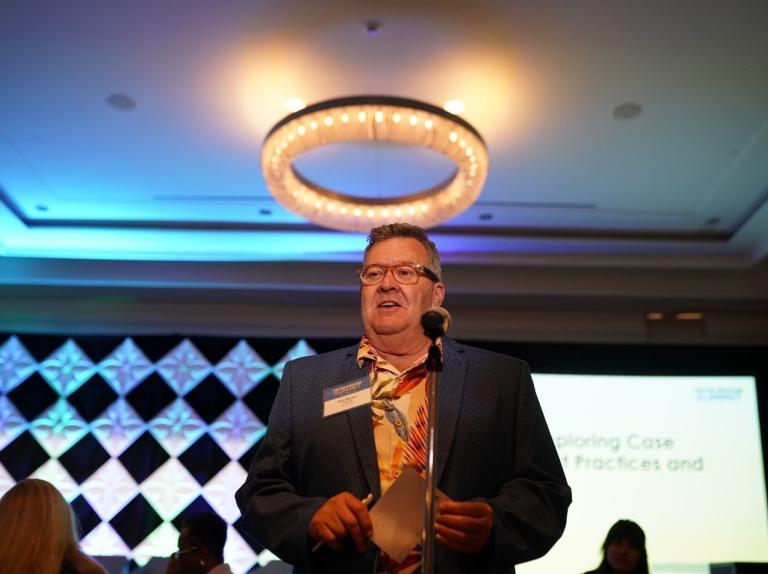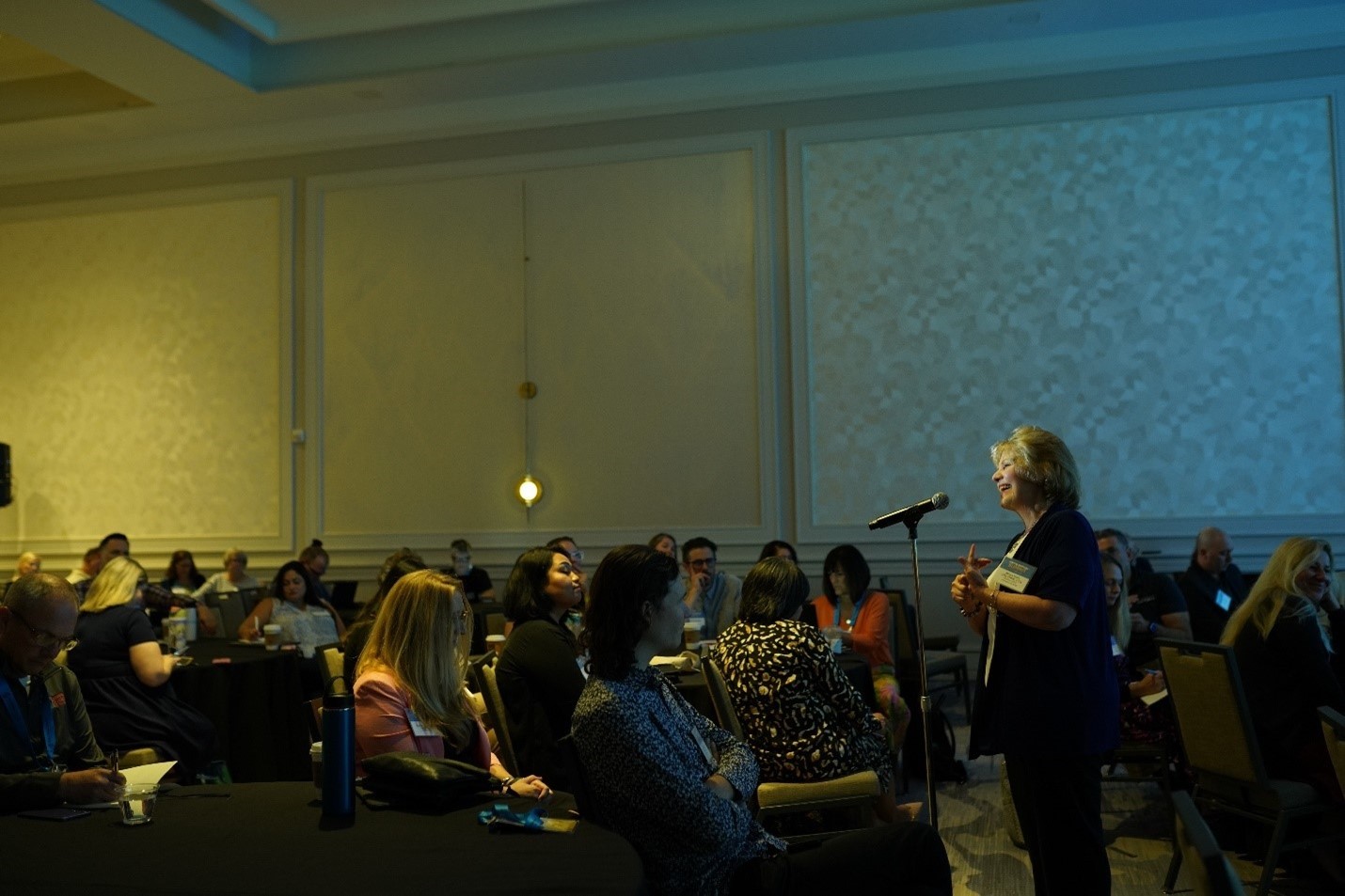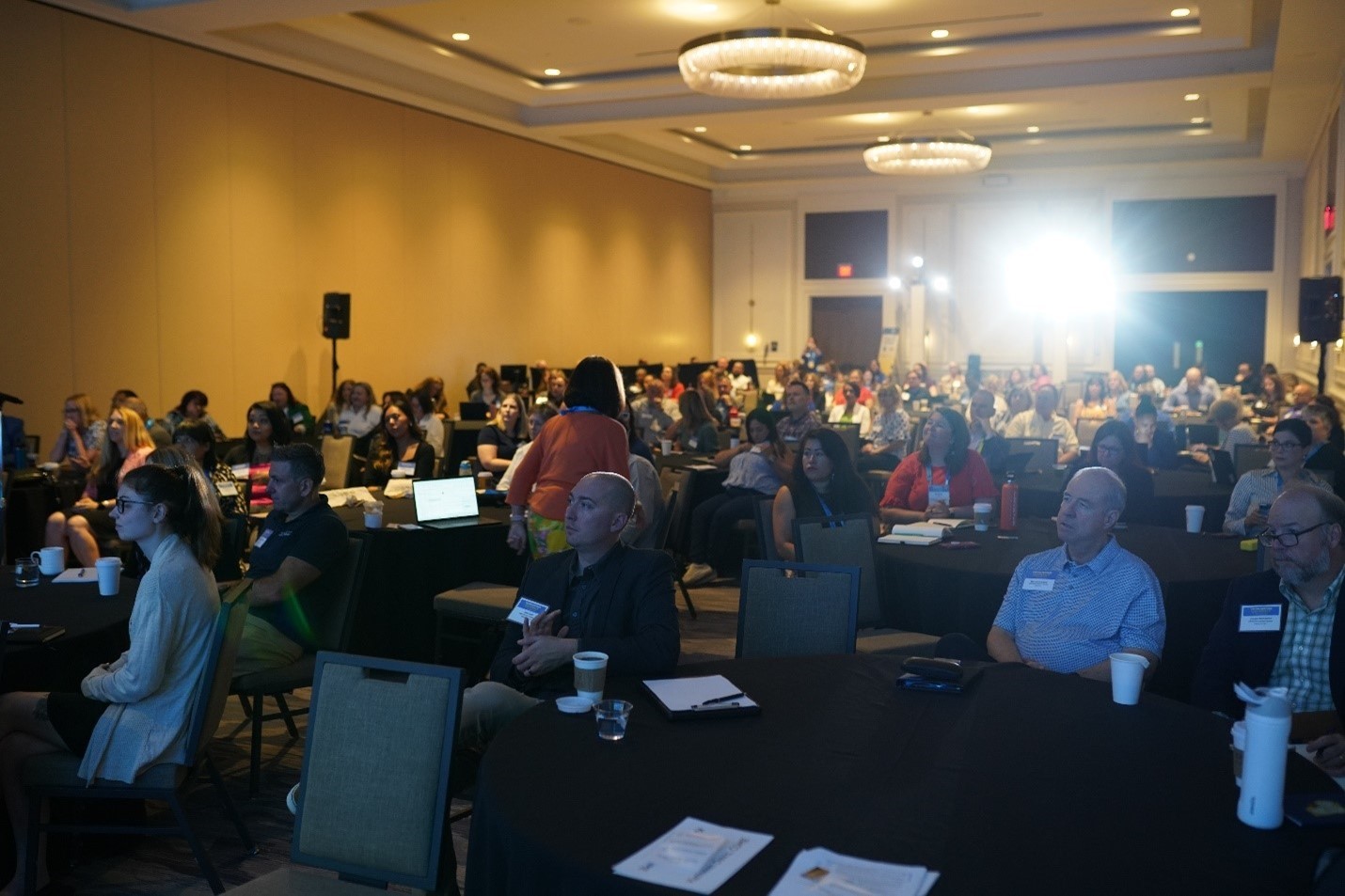
Community Connection Professionals Task Force members share their insights on the top trends in visitor services and destination development, spanning destinations from Medellin, Colombia, to Tualatin Valley, Oregon, USA.
This July, I enjoyed emceeing my first event: the Destinations International (DI) Visitor Services Summit in Tampa, Florida. In a room buzzing with energy from 125 diverse attendees, we spent the day focusing on key strategies and trends in visitor services. This motivated group candidly shared their insights and challenges around leveraging technology, fostering community engagement, and adapting to evolving visitor needs.
I was truly impressed by this group’s willingness to share.
During our 60-in-60 session, we invited attendees to step up to the mic and share their successes and pain points. A queue of willing participants manifested—starting at the mic, cutting across the room, and snaking back toward the AV table near the door!
Fully recovered from a busy week in Tampa, I returned to my desk to ask Community Connection Professionals Task Force members to weigh in with their thoughts on the key trends uncovered at the event. As staff liaison for this task force, I meet with these professionals monthly to share knowledge, identify issues, and develop solutions around the emerging challenges of community engagement and destination development.
Below, you’ll find insights from all corners of the visitor services and destination development world, spanning destinations from Medellin, Colombia, to Tualatin Valley, Oregon, USA.

1. Technology Integration
Destinations are incorporating technology to enhance visitor experiences. This includes using virtual reality, AI-powered chatbots, and QR codes to provide information and engage visitors. Mobile visitor centers and digital displays are also being used to extend reach.
- “We're here to help” has been our leading strategy for the last couple of years. Understanding visitors' perspectives and meeting them where they are, both physically and generationally, has guided our approach. Our goal is to ensure that the curated experiences and information available at our Visitors Center can also reach those who can't visit us in person or aren't sure how to find us. We are currently achieving this by including QR codes in collateral where appropriate and in suburban hotels, deploying digital kiosks at key points of interest, and enhancing our chatbot services to connect with all kinds of visitors.” Mary Quinn Ramer, President and Julie Schickel Director of Visitor Services, VisitLEX
- “In order to have a tool that connects us with the new tourist generation we created the MedellinTravel APP, which is an innovative mobile application designed to improve the experience of travelers visiting the city of Medellin. The application offers a complete guide to tourist destinations in Medellin, city attractions, must-sees, events, restaurants, and local activities. The app is designed to provide accurate and real-time information, helping users plan their trip and explore the city efficiently. Its architecture includes home, links of interest, discounts section, camera with integrated augmented reality, city map with georeferencing of the main tourist attractions of the city. Additionally, emergency lines in case you need help from anywhere and a podcast-type audio guide.” Yuliana Ruíz Velasquez, Ejecutiva de Turismo de Reuniones, Greater Medellin Convention & Visitors Bureau
- “Our mobile visitor centers go to where we already know our visitors are and engage them to visit another part of our destination. They are especially impactful at events to drive repeat visitation.” Courtney Cacatian, Executive Director, Charlottesville Albemarle Convention & Visitors Bureau
- “Technology can't be used to replace humanity, but instead should be used to extend the reach of the destination (beyond what staff resources can accommodate) and enhance the ability of the DMO to provide information at scale.” Matt Stiker, Madden Media
- “Little Rock is one of our newest CTA destinations. They just launched their mobile visitor center and had a community-wide contest to name it. The outside of the van is wrapped and says, BIG ON LITTLE ROCK, which is their brand theme. After the van was unveiled to the public, 200 citizens completed a naming contest. P - E - B - B - L - E was the winner, which stands for: Promote Every Bit of Big Little Rock Excitement
Equipped with a visitor info counter, television, and brochure racks, the van is located at local events throughout the year and travels to other states.” Mickey Schaefer, FASAE, CAE, CTA, CTA Network LLC - “We've seen more of our partners inquiring about the use of QR codes for their Bandwango passes lately. We've also seen more destinations seeking ways to integrate social sharing into their pass strategies. With the evolving goals of our DMO partners, our development team has prioritized their specific technology needs and have been excited to roll out these new pass features recently.” Brandy Hastings, Partner Success Director, Bandwango

2. Community Engagement
Building strong relationships with local businesses and residents is essential. Several destinations highlighted successful initiatives like ambassador programs, partner pop-ups, and collaborative marketing efforts.
- “One of our most impactful programs is our Strategic Investment Grant Program: Explore Tualatin Valley’s (ETV) Strategic Investment Grant Program is a competitive award program launched in Fiscal Year 2024 and is offered to organizations and projects that serve as a platform for cultural and economic growth, while inspiring destination awareness and overnight visitation to Washington County, Oregon.
Collaborative relationships are also central to our success. Explore Tualatin Valley values collaborative relationships with our partners, stakeholders, and the broader Washington County community. We passionately strive to be a relevant organization, representing the values of the community that we promote. These connections enable us to provide compelling marketing and storytelling opportunities to share with leisure, group, and day visitors.
We host a partner and stakeholder event each year during National Travel and Tourism Week and highlight community assets: In Fiscal Year 2024, we highlighted agriculture and created a hosted farmers market for our tourism partners, chambers, downtown associations, elected officials, and other key community leaders. We also highlighted tourism impact and what it means to our communities by placing four distinct messages on 10 digital billboards throughout Tualatin Valley on several major highways.” Nicole Bradin, Community Engagement Director, Explore Tualatin Valley - “Building and nurturing local relationships has been a key priority for VisitLEX since before the pandemic, but the need for community support intensified in 2020, as it did in every city. Our focus now includes an updated strategy for connecting with industry partners, the launch of a destination training program available to all local stakeholders, resident sentiment surveys, joint promotional efforts with key points of interest, and support for community-enhancing initiatives. These efforts are central to our current priorities.” Mary Quinn Ramer, President and Julie Schickel Director of Visitor Services, VisitLEX
- “In Medellín we always have cared for helping vulnerable communities and for trying that the events that we bring to the city beyond their economic impact also leave a positive social impact in people. With that in mind we started a project that we call Social Legacy to bring together event owners with nonprofit organizations and develop activities to benefit different communities of the city. The first step was creating a catalog with social initiatives that meeting owners or organizers could link to their events. This compendium seeks to serve as a platform that encourages collaboration, support and the creation of links with international and national events that share a vision of a more equitable and sustainable world. Since last year we have helped several events develop approximately 20 activities with these non-profit organizations. Some of those have been visual health brigades, cultural and artistic shows with artists of vulnerable communities, open talks for students in events, buying souvenirs from local farms or artists, among others.” Yuliana Ruíz Velasquez, Ejecutiva de Turismo de Reuniones, Greater Medellin Convention & Visitors Bureau
- “It’s difficult to promote a place where the community doesn’t have a sense of pride. Through engaging with the community, we’re able to educate them on why our work matters but also see their home through new eyes and generate excitement.” Courtney Cacatian, Executive Director, Charlottesville Albemarle Convention & Visitors Bureau
- “We added “community engagement” to my title specifically to educate our industry partners and stakeholders that we are committed to assisting them with a variety of needs including marketing, funding, being a part of the discussion to find solutions to social issues and sharing resources that otherwise might not be readily available to them. We are creating a custom destination training program originally for front-line staff, but with positive feedback from our healthcare and business community we are expanding the program to meet other industry's needs.” Tiffany Ahalt, Director of Sales & Community Engagement, Visit Hagerstown
- “In any pitch to engage others there has to be a degree of WIIFM - what's in it for me. Often DMO leaders are seen by partners as government or non-profit employees who couldn't possibly understand how to make a profit in a business. That's where real peer success stories come in. Independent third-party verification can go a long way with those on the fence about engaging with your efforts or not. Who do you know that has given positive feedback on their involvement? Record that in a WIIFM voice and yell it from the rooftops!” Phil Bruno, Treat ‘Em Right
- “Community engagement is more than building relationships; it's creating industry investors, people who may not be directly employed by/impacted by tourism but understand its value and are willing to advocate on its behalf.” Matt Stiker, Madden Media
- “Gone are the days when paid advertising and isolated efforts were enough to drive tourism. Today, travelers crave real experiences and genuine interactions. By involving residents as key spokespeople for the destination, we not only enhance the visitor experience but also instill a sense of pride in the city’s unique charm. This shift in perspective turns residents into vital advocates, or ambassadors, ensuring that the destination remains a place people eagerly want to return to.” Cassandra Klein, Account Director, TripScout

3. Adapting to Changing Visitor Needs
The summit emphasized the need to cater to diverse visitor preferences. This includes providing accessible information, personalized itineraries, and catering to different communication styles (e.g., texting programs). Measuring success through quantitative and qualitative data is also crucial. Destinations are tracking visitor interactions, health scores, and promoter scores to gauge the effectiveness of their strategies.
- “Even minimal work to incorporate visitor preferences goes a long way. Visitors and prospective visitors get so excited to see a bit of themselves in a destination. If that excitement also comes with education on how to build a successful trip, you have them hooked!” Courtney Cacatian, Executive Director, Charlottesville Albemarle Convention & Visitors Bureau
- “Similar to the previous topic, it’s crucial to recognize that all visitors, regardless of their needs, age, or cultural background, are seeking fulfilling experiences. It is of utmost importance that we remain “here to help” in every possible way. To better communicate our accessibility and sustainability initiatives, we recognized the need to enhance how we share information about our existing accessibility options and our commitment to sustainability with both visitors and locals. With the launch and implementation of the Sunflower Program, providing sensory kits from our Visitors Center, and our partnership with Wheel the World, we are further advancing our efforts to create a more inclusive environment. Additionally, prioritizing our support and engagement with the LGBTQ+ community and underrepresented community members is essential. We are committed to ensuring that the marketing of our community as a destination accurately reflects its diversity.” Mary Quinn Ramer, President and Julie Schickel Director of Visitor Services, VisitLEX
- “The most important skills here are empathy, curiosity and vulnerability; allowing your guests to believe that you want to SEE them and HEAR them will help them understand that you view them as individuals, and you're willing to find individual solutions for what works best for them.” Matt Stiker, Madden Media
- “From my own time in the DMO world, I always found it important to look deeper than just the impression numbers that my marketing provided. An impression doesn't walk into a local business and spend money, but a person does. I now hear the same thing from many of our partners as they tell me how crucial live data is for them as well - and how much they value the real-time, live data that they are able to see with their digital Bandwango passes. They're able to prove exactly how many people they're sending through the doors of their local businesses and gain important insights about those visitors. This real-time data has been a game changer in our industry.” Brandy Hastings, Partner Success Director, Bandwango

4. Staffing and Partnerships
Destinations are exploring innovative staffing models, including volunteer programs and partnerships with chambers and local businesses, to optimize resources and extend their reach.
- “Workforce development is one of the top areas that our industry is addressing. In addition to traditional methods of recruiting, educating, and training we can be innovative in our approach to positions at our visitor centers and in our workspaces. We encourage the smaller main street communities to create a welcome center/business/non-profit approach for shared spaces. This allows for paid staff and volunteers to keep the doors open and serve residents and visitors. This also allows them to save money, be eligible for grants, and create a greater sense of pride within the community and a genuine sense of being welcomed by visitors.” Tiffany Ahalt, Director of Sales & Community Engagement, Visit Hagerstown
- “Ambassador programs like those adopted by SF Travel and others accomplish more than just stretching limited DMO budgets; they invite new perspectives into the destination, they create advocates who see the value of the industry and will support it, and they have the ability to provide support in lesser-visited areas of town, supporting industry members who may not always feel connected to the rest of the destination.” Matt Stiker, Madden Media
- “The CTA program is being used to fill the 'call for volunteers' for festivals and fairs and has helped CTA destinations keep these events 'afloat' with FREE help - volunteer CTAs - vs. paid staff. Our CTA destination CEOs see this as strong benefit of the CTA program. CTAs receive points for volunteering, which goes toward their annual renewal of certification – which helps increase overall destination volunteering.” Mickey Schaefer, FASAE, CAE, CTA, CTA Network LLC
5. Physical vs. Digital
The role of physical visitor centers is evolving. Some destinations are investing in renovations and experiential elements, while others are focusing on digital outreach and mobile visitor centers. The balance between physical and digital engagement is a key consideration.
- “Regardless of the expression of the brand, the experience provided should touch the emotion that your brand promises it will with a visit. Both live and digital experiences can do that, but it takes a lot of creativity and can't be done with traditional "marketing speak." I love this article on Brand Emotions” Phil Bruno, Treat ‘Em Right
- “It's not either/or, it's both/and. What your guests need will largely be based on how they assimilate information and should not be limited to just one form or channel. The impact and scalability of digital is unparalleled, but so is the ability to connect physically with other human beings and provide an analog experience for those to whom that matters.” Matt Stiker, Madden Media
- "High Tech, High Touch has been top-of-mind for decades. While visitors appreciate digital experiences, they still appreciate someone taking time to help them one-on-one. We are a people society. Deep down, we crave the personal touch. That will never change." Mickey Schaefer, FASAE, CAE, CTA, CTA Network LLC

The world of visitor services is transforming, driven by technological advancements, a renewed focus on community engagement, and visitors' ever-evolving needs. From AI-powered chatbots to ambassador programs, the trends we've explored showcase the innovative ways destinations are adapting and thriving.
By embracing these trends, you can create unforgettable visitor experiences, strengthen your community connections, and ensure your destination remains a top choice for travelers.
Take inspiration from the innovative ideas shared by your peers and explore how you can implement them in your destination. Learn about DI’s strategic priority of Community Alignment and Engagement and share your thoughts on these trends in the DI Online Community.
Submit Your Thought Leadership

Share your thought leadership with the Destinations International team! Learn how to submit a case study, blog or other piece of content to DI.


